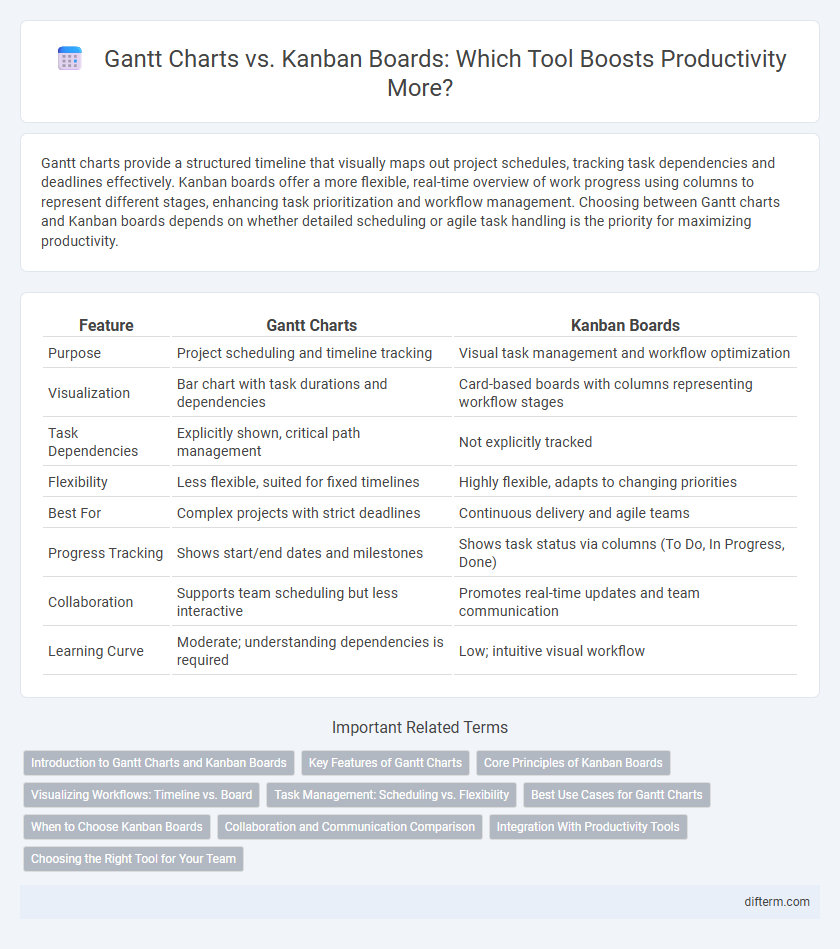Gantt charts provide a structured timeline that visually maps out project schedules, tracking task dependencies and deadlines effectively. Kanban boards offer a more flexible, real-time overview of work progress using columns to represent different stages, enhancing task prioritization and workflow management. Choosing between Gantt charts and Kanban boards depends on whether detailed scheduling or agile task handling is the priority for maximizing productivity.
Table of Comparison
| Feature | Gantt Charts | Kanban Boards |
|---|---|---|
| Purpose | Project scheduling and timeline tracking | Visual task management and workflow optimization |
| Visualization | Bar chart with task durations and dependencies | Card-based boards with columns representing workflow stages |
| Task Dependencies | Explicitly shown, critical path management | Not explicitly tracked |
| Flexibility | Less flexible, suited for fixed timelines | Highly flexible, adapts to changing priorities |
| Best For | Complex projects with strict deadlines | Continuous delivery and agile teams |
| Progress Tracking | Shows start/end dates and milestones | Shows task status via columns (To Do, In Progress, Done) |
| Collaboration | Supports team scheduling but less interactive | Promotes real-time updates and team communication |
| Learning Curve | Moderate; understanding dependencies is required | Low; intuitive visual workflow |
Introduction to Gantt Charts and Kanban Boards
Gantt charts visually represent project timelines by displaying tasks as horizontal bars along a calendar, enabling clear tracking of deadlines and dependencies. Kanban boards organize work into columns representing different stages, promoting continuous workflow and real-time task management. Both tools enhance productivity by providing structured visualization tailored to project complexity and team collaboration needs.
Key Features of Gantt Charts
Gantt charts provide a visual timeline that highlights task dependencies, start and end dates, and project milestones, enhancing scheduling accuracy. They enable managers to allocate resources effectively and track project progress in a linear, time-based format. Detailed task breakdowns and progress bars allow for precise monitoring of deadlines and overall project duration.
Core Principles of Kanban Boards
Kanban boards emphasize visual workflow management by using cards and columns to represent tasks and their progress, enabling real-time work tracking. The core principles include limiting work in progress (WIP) to enhance focus and reduce bottlenecks, managing flow to optimize task completion speed, and making process policies explicit for team clarity. Continuous improvement is integrated through regular evaluations, helping teams adapt and refine their workflow efficiency.
Visualizing Workflows: Timeline vs. Board
Gantt charts provide a timeline view that helps teams visualize project schedules, dependencies, and deadlines with precision, making it easier to track progress over time. Kanban boards offer a dynamic, card-based interface focused on workflow stages, allowing teams to monitor task status visually and manage work-in-progress limits. Both tools enhance productivity by tailoring visual workflow management to different project needs--schedule-driven versus process-driven.
Task Management: Scheduling vs. Flexibility
Gantt charts excel in task management by providing a clear, time-based schedule that maps out project timelines and dependencies, ensuring precise deadline tracking and resource allocation. Kanban boards offer superior flexibility, enabling teams to visualize work in progress and easily adjust priorities or workflows based on real-time changes. The choice between Gantt charts and Kanban boards hinges on the need for structured scheduling versus adaptive task flow management in productivity optimization.
Best Use Cases for Gantt Charts
Gantt charts excel in managing complex projects with multiple interdependent tasks and strict deadlines, providing a clear visual timeline for tracking progress and resource allocation. They are best suited for project managers who need to plan, schedule, and monitor tasks sequentially, ensuring milestones and dependencies are met efficiently. Industries like construction, software development, and event planning often rely on Gantt charts for detailed project oversight and timeline management.
When to Choose Kanban Boards
Choose Kanban boards when flexibility and continuous workflow visualization are priorities, especially for projects with evolving priorities and frequent task updates. Kanban is ideal for teams aiming to limit work in progress and optimize task cycle times, enhancing productivity in agile environments. It excels in managing ongoing processes where tasks require constant reprioritization and real-time collaboration.
Collaboration and Communication Comparison
Gantt charts offer a structured timeline that enhances collaboration by clearly defining task dependencies and deadlines, facilitating synchronized team efforts. Kanban boards improve communication through visual workflow management, enabling real-time updates and transparency that support dynamic team interactions. Both tools drive productivity by aligning team members but prioritize collaboration and communication in distinct ways--Gantt charts emphasize planning clarity, while Kanban boards foster continuous dialogue.
Integration With Productivity Tools
Gantt charts integrate seamlessly with project management tools like Microsoft Project and Smartsheet, enabling detailed timeline tracking and resource allocation. Kanban boards excel in flexibility, syncing effortlessly with collaboration platforms such as Trello, Jira, and Asana to facilitate real-time task updates and workflow visualization. Both tools enhance productivity by supporting integration with time-tracking applications, communication software, and automated notification systems.
Choosing the Right Tool for Your Team
Gantt charts provide a visual timeline ideal for planning complex projects with fixed deadlines and interdependent tasks, enabling precise tracking of progress and resource allocation. Kanban boards emphasize workflow visualization and task management through dynamic columns, promoting flexibility and continuous improvement in team productivity. Selecting the right tool depends on your team's project structure, the importance of scheduling versus adaptability, and the preferred method for monitoring task progress.
Gantt charts vs Kanban boards Infographic

 difterm.com
difterm.com